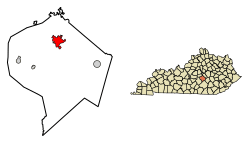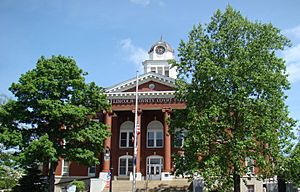Stanford, Kentucky facts for kids
Quick facts for kids
Stanford, Kentucky
|
|
|---|---|

Historic Commercial District
|
|

Location in Lincoln County, Kentucky
|
|
| Country | United States |
| State | Kentucky |
| County | Lincoln |
| Area | |
| • Total | 4.47 sq mi (11.58 km2) |
| • Land | 4.44 sq mi (11.49 km2) |
| • Water | 0.04 sq mi (0.09 km2) |
| Elevation | 935 ft (285 m) |
| Population
(2020)
|
|
| • Total | 3,640 |
| • Estimate
(2022)
|
3,644 |
| • Density | 820.56/sq mi (316.83/km2) |
| Time zone | UTC-5 (Eastern (EST)) |
| • Summer (DST) | UTC-4 (EDT) |
| ZIP code |
40484
|
| Area code(s) | 606 |
| FIPS code | 21-73110 |
| GNIS feature ID | 2405519 |
Stanford is a city in Lincoln County, Kentucky, in the United States. It's known as a "home rule-class city," which means it has the power to manage its own local affairs.
Stanford is one of the oldest settlements in Kentucky. It was founded way back in 1775. In 2020, about 3,640 people lived there. Stanford is also the county seat of Lincoln County, meaning it's where the main government offices for the county are located. It's part of the area around Danville.
Contents
History of Stanford
Early Settlement and Fort Logan
Stanford was first settled in 1775 by a person named Benjamin Logan. He called the settlement "St. Asaph," but people also knew it as "Logan's Fort." This fort was about a mile west of where the main courthouse is today. Even now, some local businesses use the name "Fort Logan," like the Fort Logan Hospital. The main street of Stanford was built on an old path that buffalo used to follow.
The name "Stanford" might have come from "Standing Fort." This name was given to Fort Logan because it was very strong. It survived many attacks by Native Americans who were working with the British during the American Revolution. Another idea is that it was named after a town in England called Stamford, England. Even though it was a smaller fort, it was never captured.
Growth and Important Buildings
In 1781, Benjamin Logan gave some of his land to help the settlement grow. This land was used to build a courthouse. The county court met in other places until 1785. By 1786, Stanford officially received its "charter." A charter is like a special document that gives a town the right to govern itself. This made Stanford one of the first towns in Kentucky to have a formal charter.
The first courthouse opened in 1787 and was made of logs. Over time, it has been made bigger and better, but it's still in the same spot. Unlike many courthouses in Kentucky, Stanford's courthouse has never had a big fire or lost its records. Lincoln County has all its original records from November 1789. This makes its archives very complete. Some old land deeds, written on special paper called vellum, show land given to famous pioneers like Daniel Boone and Simon Kenton.
Churches, Libraries, and Schools
The first church in Stanford was a Presbyterian church, built in 1790. This shows how strong the Logan family's Presbyterian beliefs were. The building is still standing today and is part of the Harvey Helm Memorial Historic Library and Museum. Other church groups, like Baptist and Methodist, started in the area later, around the 1830s. The current Presbyterian Church in Stanford has been in the same place since about 1850.
A small local library first opened in the 1830s. In 1970, it was renamed the Harvey Helm Memorial Historic Library and Museum. This was to honor Harvey Helm, who was from Stanford and became a important politician. He was a member of the United States House of Representatives from 1909 to 1917.
The first school, called the Male Academy, was built around the 1850s. It's now the Fox Funeral Home. A school for girls, the Female Academy, was built in the 1870s. The Stanford School started in 1900. After growing a lot, it is now the Lincoln County Student Support Center.
Post-Civil War Development
Stanford was mostly unaffected by the American Civil War. The closest big battle was the Battle of Perryville, about 20 miles (32 km) away. After the war, Stanford grew a lot. In the late 1860s, the town got its own newspaper, the Stanford Banner. This newspaper is still published today as the Interior Journal.
The city continued to grow, especially after the Louisville and Nashville Railroad built a train station and tracks into the town in late 1865. The railroad line is now closed, and the tracks were removed in 1988. Only a small part of the track remains, connecting to Mount Vernon, about 24 miles (39 km) away. The old train depot has been fixed up. Stanford is also famous for having Kentucky's first car garage, which opened in 1905.
Geography of Stanford
Stanford is located in the southern part of Kentucky. It's in the southern tip of the Bluegrass region and along the northern edge of the Southern Knobs area. This is in northern Lincoln County.
U.S. Route 27 goes through the east side of Stanford. This road leads northeast about 8 miles (13 km) to Lancaster and 43 miles (69 km) to Lexington. If you go south on Route 27, it's about 32 miles (51 km) to Somerset.
U.S. Route 150 goes through the northern part of the city. This road leads northwest about 10 miles (16 km) to Danville and southeast 24 miles (39 km) to Mount Vernon.
According to the United States Census Bureau, Stanford covers a total area of about 4.47 square miles (11.58 square kilometers). A very small part of this, about 0.04 square miles (0.09 square kilometers), is water.
Population Information
| Historical population | |||
|---|---|---|---|
| Census | Pop. | %± | |
| 1800 | 66 | — | |
| 1830 | 363 | — | |
| 1840 | 263 | −27.5% | |
| 1860 | 479 | — | |
| 1870 | 752 | 57.0% | |
| 1880 | 1,213 | 61.3% | |
| 1890 | 1,385 | 14.2% | |
| 1900 | 1,651 | 19.2% | |
| 1910 | 1,532 | −7.2% | |
| 1920 | 1,397 | −8.8% | |
| 1930 | 1,544 | 10.5% | |
| 1940 | 1,940 | 25.6% | |
| 1950 | 1,861 | −4.1% | |
| 1960 | 2,019 | 8.5% | |
| 1970 | 2,474 | 22.5% | |
| 1980 | 2,764 | 11.7% | |
| 1990 | 2,686 | −2.8% | |
| 2000 | 3,430 | 27.7% | |
| 2010 | 3,487 | 1.7% | |
| 2020 | 3,640 | 4.4% | |
| 2022 (est.) | 3,644 | 4.5% | |
| U.S. Decennial Census | |||
In 2000, there were 3,430 people living in Stanford. There were 1,417 households, which are groups of people living together in one home. About 919 of these were families. The population density was about 1,114 people per square mile (430 people per square kilometer).
Most of the people living in Stanford were White (about 90%). About 8% were African American. A small number of people were from other racial backgrounds. About 1.4% of the population was Hispanic or Latino.
About 22.8% of the people were under 18 years old. The average age in Stanford was 38 years. For every 100 females, there were about 84 males.
The average income for a household in the city was $25,087. For families, the average income was $32,550. About 20.6% of the population lived below the poverty line. This included about 27.4% of those under 18 and 27.8% of those 65 or older.
Education in Stanford
Stanford has a lending library for everyone to use. It's called the Lincoln County Public Library.
Notable People from Stanford
- Marv Foley, a baseball player
- Anthony Gale, who was a commandant (leader) of the United States Marine Corps
- Basil Hayden, a great athlete and basketball coach in college
- Harvey Helm, a congressman and important statesman
- Laura Kirkpatrick, who was the runner-up on the TV show America's Next Top Model
- California Joe Milner, a miner and frontier scout
- Lovell Rousseau, a Major General in the Union Army during the Civil War and a congressman
- Richard C. Saufley, a pioneer in naval aviation (flying for the navy)
- William Lewis Sublette, a fur trapper, pioneer, and mountain man. He and his brothers became important in the Rocky Mountain Fur Company.
- William Whitley, an early pioneer
- Thomas J. Wright, an artist and filmmaker, known for his work on the TV show Night Gallery
See also
 In Spanish: Stanford (Kentucky) para niños
In Spanish: Stanford (Kentucky) para niños


